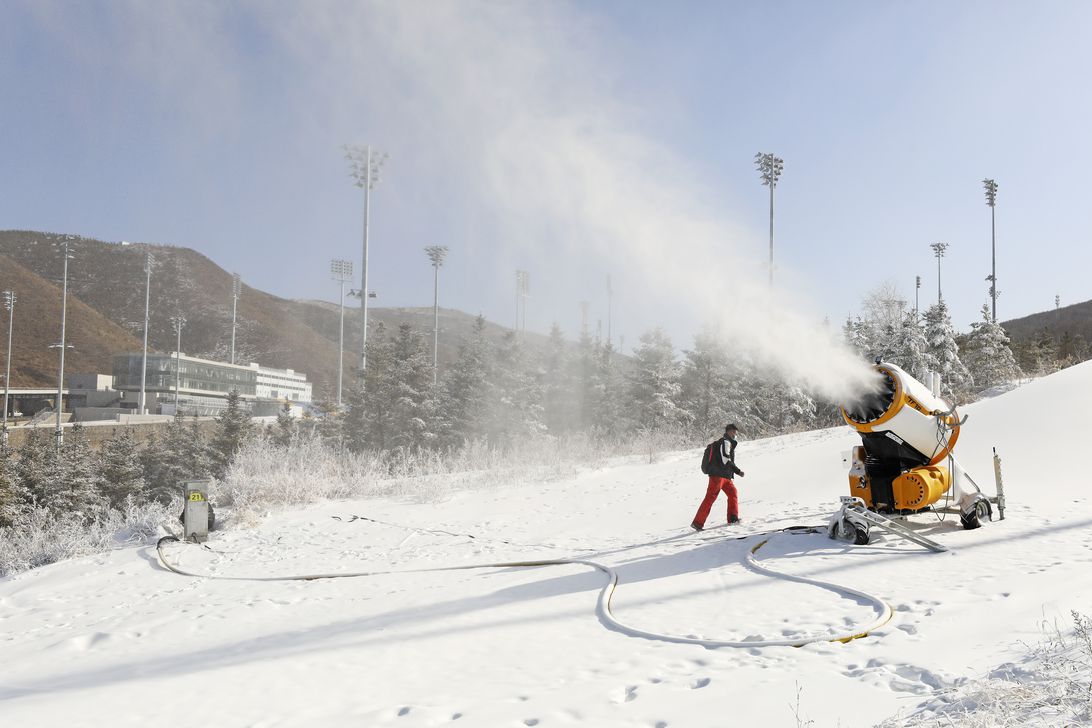Technologies
Winter Olympics: No snow, no problems… yet
The Beijing Games use almost 100% artificial snow, as climate change threatens to change winter sports forever.

Organizers of the 2022 Winter Olympics, which officially opened on Friday, have been using dozens of snow generators and hundreds of snowblowers to create 1.2 million cubic meters of powder (or about 42.4 million cubic feet).
The Games in Beijing will mark the first time athletes will compete almost entirely on artificial snow, according to a report from London’s Loughbough University.
That’ll likely become the norm as climate change continues, according to the report’s findings, «starting with lower-altitude slopes and raising pressure and costs on higher-[altitude] resorts.»
But generating fake snow has a high environmental cost, the authors say. «Even if powered by renewables, a huge amount of energy is needed which is both costly and can be a significant drain on water resources.»
And winter athletes say the artificial turf is less safe.
«Artificial snow is icier, therefore faster and more dangerous,» Estonian biathlete Johanna Taliharm told the Associated Press in January. «It also hurts more if you fall outside of the course when there is no fluffy snowbank, but a rocky and muddy hard ground.»
Team USA cross-country coach Chris Grover said landing in it «can feel like falling on concrete.»
Not everyone is critical of the fake stuff. Australian snowboarder Matt Cox, who’s making his Olympic debut at Beijing, told Reuters that «with the cold temps here, it’s dreamy snow.»
Artificial snow is more of a tightly packed frozen slush, made from water droplets that are broken up by a high-pressure pump and then crystalize into frozen flakes.
Read more: How to watch the Beijing Winter Olympics: Everything to know
The International Olympic Committee maintains that artificial snow is used regularly at International Ski Federation competitions «and does not make the courses more dangerous.»
«To the contrary, it creates a more consistent surface from the top to bottom — or start to finish — of a course,» an IOC spokesperson told CNET. «The iciness and density of the surface is dependent on the needs of the given competition and the preparation of the course, not on the source of the snow.»
Most ski and snowboarding events at the Beijing Games will take place in Zhangjiakou, about 110 miles northwest of Beijing, including freestyle, cross-country, ski jumping and biathlon. Skating and several additional snow events are being held at the Capital Indoor Stadium in central Beijing.
Bobsled, luge and Alpine skiing events will be held in Yanqing, a mountainous area about 45 miles from downtown Beijing that’s rich in water resources, according to the IOC. Water supplies for the Olympic venues there will come from the nearby Foyukou Reservoir.
The IOC says that the electricity used to make the snow is from renewable wind and solar energy sources. In addition, water-conservation efforts have been instituted, including snow farming — preserving and relocating previous accumulation — and harvesting melted snow in retaining lakes at the end of the season.
According to the committee, water usage related to snow sports for the Games won’t impact nearby citizens’ consumption or agriculture needs.
«The regions where the snow-sport events will be held are constantly very cold,» the IOC representative said. «This allows a very efficient snow production and does not require the constant reproduction of snow, like in many ski resorts elsewhere in the world where the temperature fluctuations lead to a regular melting of the snow during a season.»
However, another recent study found that, by the year 2080, only one of the past 21 Winter Olympic hosts will still have sufficient winter conditions for the Games.
The ideal conditions for making artificial snow are a «wet-bulb temperature» of about 20 degrees Fahrenheit, representing a combination of the actual temperature and the amount of moisture in the air. But the 2026 Winter Games are slated to be held in Milan, where temperatures rarely dip that low.
The 2022 Winter Olympics in Beijing opened on Feb. 4 and will run until Feb. 20.
Technologies
The Black Friday Gaming Deals You Want Are Already Here, Including PlayStation, Xbox and Alienware
Technologies
The Black Samsung Galaxy Z Fold 7 Is at a Record $443 Off at Amazon for Black Friday
A Galaxy Z Fold 7 price war between Amazon and Samsung gives us a record-low deal for one color.

If you’re looking for a foldable iPhone, you’re gonna need to wait until 2026, but if you’re looking for the best foldable phone of 2025, there are great deals on the Galaxy Z Fold 7 right now at both Amazon and Samsung, with the former dropping the black version of Samsung’s foldable phone to a record-low $1,557. All other models are $1,600 at both Amazon and Samsung, a $400 discount.
Samsung’s unique foldable phones had an awkward adolescence, but after getting her hands on the new lineup, CNET reviewer Abrar Al-Heet confirms that the latest Z Fold 7 «just feels right.» For one, it’s incredibly sleek at just 8.9mm thick when closed or 4.2mm thick when open, which is so thin you may even forget that it’s foldable.
Hey, did you know? CNET Deals texts are free, easy and save you money.
Despite weighing just 215 grams, this foldable features some serious hardware. It has a 6.5-inch cover screen and an 8-inch interior display with a fluid 120Hz refresh rate. It’s equipped with a cutting-edge Snapdragon 8 Elite processor and 12GB of RAM to support tons of helpful AI features and functions, and comes with Android 16 and Samsung One UI 8 right out of the box.
The camera system is also pretty impressive, boasting a 200-megapixel rear camera, 12-megapixel ultrawide shooting and a 10-megapixel front camera on both the cover and interior screens. Plus, it’s equipped with a 4,400-mAh battery for all-day use.
MOBILE DEALS OF THE WEEK
-
$749 (save $250)
-
$475 (save $175)
-
$499 (save $300)
-
$900 (save $400)
Why this deal matters
With an unbelievably sleek design and cutting-edge hardware, the impressive Samsung Galaxy Z Fold 7 is our favorite foldable phone on the market. But it also comes with a staggering $2,000 price tag, and if you’re hoping to get your hands on one, this $443 discount is a way to rack up some serious savings and help cushion the blow of its considerable cost. Just be sure to get your order in soon, as we doubt this deal will remain live for long.
Join Our Daily Deals Text Group!
Get hand-picked deals from CNET shopping experts straight to your phone.
By signing up, you confirm you are 16+ and agree to receive recurring marketing messages at the phone number provided. Consent is not a condition of purchase. Reply STOP to unsubscribe. Msg & data rates may apply. View our Privacy Policy and Terms of Use.
Technologies
I Almost Missed This Deal Within a Deal for Baseus’ Bose-Infused Headphones and Earbuds
Baseus’ new Inspire XH1, XP1 and XC1 models with Sound by Bose are 23% to 33% off for Black Friday and Cyber Monday. But Baseus throws in its BC1 clip-on earbuds or other «free» bonus items to make the deal even sweeter.

I gave CNET Editors’ Choice awards to Baseus’ Bose-infused Baseus Inspire XH1 headphones and Inspire XP1 earbuds because they’re well designed and sound decent for what they cost. I also liked Baseus’ Inspire XC1 clip-on earbuds, which have dual- drivers and earned a spot on CNET’s best clip-on earbuds list.
Last week all three models were selling for around $110 (though they have higher list prices), but they’re now discounted to around $100 for Black Friday and Cyber Monday. That’s a deal I’d highlight on its own, but if you click through to any of those models’ Amazon product pages an look closely you’ll see that each is eligible for «one free item» with purchase.
Read more: Best wireless earbuds of 2025
You have to click the «how to claim link» and then add one of the three products to the your cart. Once one of the headphones or earbuds is added to your cart, you can click a button on the left side of screen (above the stars for average ratings) that switches the view from «qualifying items» to «benefit items.» You can then add Baseus’s BC1 clip-on earbuds, which list for $40, to your cart as a free item. Baseus’ step-up Basues MC1 Pro ($48 for Black Friday) and Inspire XC1 clip-on buds sound better, but the BC1 are fine for casual use.
If the BC1 earbuds option doesn’t thrill you, there are other freebies you can opt for. Just go back to the Amazon product page for the Inspire XH1, XP1 and XC1 and you’ll see options for one free item with $100, $90, $51 and $46 purchases. The $90 benefit item is a 30W dual-port fast charger (list price $20), which is decent, and the $51 benefit item is a retractable USB-C cable ($19 list) that’s useful. Don’t bother with the $46 benefit item.
You can read my full reviews of the Inspire XH1 headphones here and the Inspire XP1 earbuds here. And here’s my quick take of the Inspire XC1 earbuds:
Like Baseus’ noise-isolating Inspire XP1 earbuds that I rated highly, the Inspire XC1 feature «Sound by Bose» and a more premium design than earlier Baseus earbuds. The XC1 don’t sound as good as the XP1, but they sound good for open earbuds and are equipped with dual drivers, one of which is a Knowles balanced-armature driver that helps improve treble performance. While they don’t produce as much bass as noise-isolating earbuds like the Inspire XP1, their bass performance is better than I expected. The buds’ sound is pretty full, especially in quieter environments, though they do better with less bass-heavy material (I did notice a bit of distortion at higher volumes with certain tracks with harder driving bass).
While I prefer the design and fit of Bose’s Ultra Open Earbuds (as well as the design of their case) and think the Bose buds sound more natural and a tad better overall, the much more affordable Inspire XC1 fit comfortably and offer top-tier sound for clip-on open earbuds (and they play louder than the Bose), as well as decent voice-calling performance with good background noise reduction.
HEADPHONE DEALS OF THE WEEK
-
$248 (save $152)
-
$170 (save $181)
-
$298 (save $131)
-
$199 (save $150)
Read more: Best Black Friday headphones deals
Join Our Daily Deals Text Group!
Get hand-picked deals from CNET shopping experts straight to your phone.
By signing up, you confirm you are 16+ and agree to receive recurring marketing messages at the phone number provided. Consent is not a condition of purchase. Reply STOP to unsubscribe. Msg & data rates may apply. View our Privacy Policy and Terms of Use.
-

 Technologies3 года ago
Technologies3 года agoTech Companies Need to Be Held Accountable for Security, Experts Say
-

 Technologies3 года ago
Technologies3 года agoBest Handheld Game Console in 2023
-

 Technologies3 года ago
Technologies3 года agoTighten Up Your VR Game With the Best Head Straps for Quest 2
-

 Technologies4 года ago
Technologies4 года agoBlack Friday 2021: The best deals on TVs, headphones, kitchenware, and more
-

 Technologies4 года ago
Technologies4 года agoVerum, Wickr and Threema: next generation secured messengers
-

 Technologies4 года ago
Technologies4 года agoGoogle to require vaccinations as Silicon Valley rethinks return-to-office policies
-

 Technologies4 года ago
Technologies4 года agoOlivia Harlan Dekker for Verum Messenger
-

 Technologies4 года ago
Technologies4 года agoiPhone 13 event: How to watch Apple’s big announcement tomorrow
